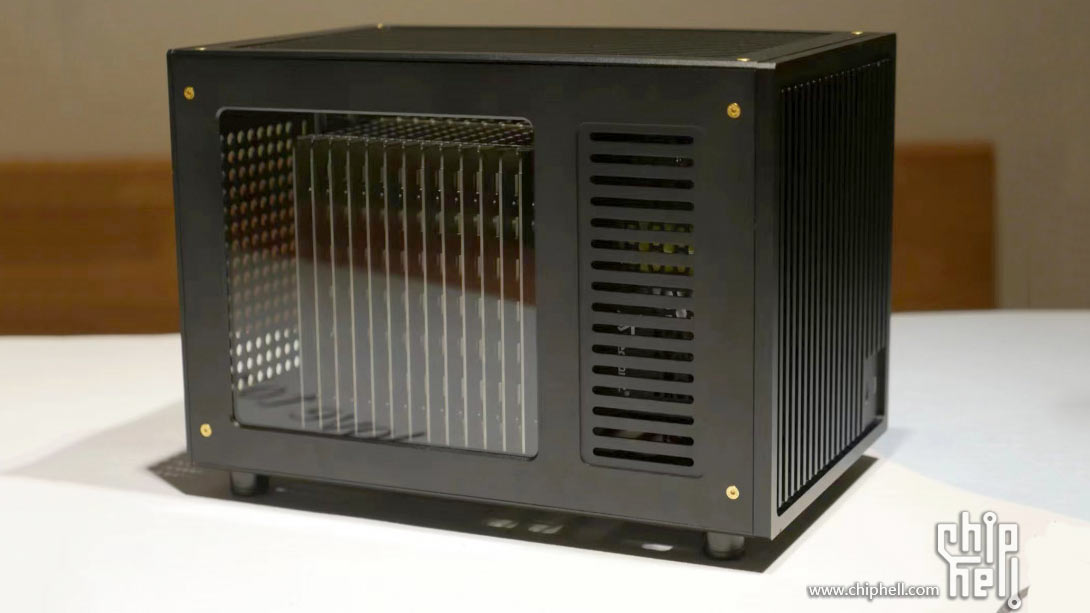Enthusiast Builds Custom SFF Case Around Noctua's NH-P1 Passive Cooler
Behold the cooler in all its aluminum finned glory
A PC enthusiast in China has built a custom PC case specifically to fit the substantial Noctua NH-P1 passive cooler — with room for little else. With a self-imposed design constraint of using a Mini-ITX platform, ChipHell’s FreshCool created a custom case measuring just 30 x 20 x 20 cm (LWH), or roughly 12 x 8 x 8–inches. The result, spotted by FanlessTech, is a pleasingly compact passive system. Moreover, it looks much like a modern manufactured case, featuring contemporary design trappings such as a side window, a generous amount of venting, and a vertically barred front. Perhaps it was Fractal North inspired.
What kind of thermal load will this passive PC system have to cope with? The system’s main heat source will be the Intel Core i7-12700, which of course has the Noctua NH-P1 attached. FreshCool says that if the CPU is limited to 65W, in testing it never strayed beyond the 50 degrees Celsius range. A 100W limit meant that the processor would run at temperatures in the mid-70s. Finally, the translation isn’t great but it seems like if the power limit is completely unlocked (140W), the 12700 will start to throttle under load after 90 seconds. We don’t have any info about what tests were run, ambient temperatures, etc.



On the quest for a truly fanless system, FreshCool chose to install a Seasonic PX450. This is a fully modular 450W PSU, and it offers 80 Plus Platinum efficiency with an attractive 12-year warranty. Other key components of the build include a Maxsun H610 ITX motherboard, 32GB of RAM (Kingston 2x16GB), and a WD Blue SN570 M.2 SSD.
In some further comments and replies on the ChipHell forums, FreshCool joked with other users about the case looking like a cooking appliance. The PC DIYer also revealed that they had previously considered using a SilverStone Sugo 16, with a comparable size but designed for active cooling. FreshCool didn’t use the Sugo after determining that "its ventilation efficiency is not good" for creating a passive system. However, for builders wanting a discrete GPU the Sugo has room for cards up to 275mm long and 147mm wide.
This custom case obviously won't win any gaming performance awards, since it lacks anything better than the integrated Intel UHD Graphics 770. That's enough for streaming video or perhaps playing Minecraft, but it falls well short of even the slowest dedicated solutions that we've tested in our GPU benchmarks. Of course, few graphics cards offer fanless solutions these days, which would defeat the point of this build.
Get Tom's Hardware's best news and in-depth reviews, straight to your inbox.

Mark Tyson is a news editor at Tom's Hardware. He enjoys covering the full breadth of PC tech; from business and semiconductor design to products approaching the edge of reason.
-
bit_user I know a guy who bought a thin laptop/convertible with no fan. He then discovered just how noisy heat pipes themselves can be! I have also experienced this with my work laptop. Even before I can hear its fan spin up, I'll hear the crackling of its heat pipes.Reply
If you know how heat pipes work, it should come as little surprise. Like air conditioning, they rely on the massive efficiency of phase-change cooling. In other words, they work by boiling the working fluid, at the heat source! Boiling fluid inside a thin metal tube obviously make noise.
So, my guess is that this builder is going to hear some sizzling and popping, if they put this thing on their desk.
Aesthetically, I don't love it or really hate it. This fanless case might find some fans, but it hasn't found one in me. -
decembermouse I'm a fan. It's not the best-looking case I've ever seen, but it's not bad compared to some of what the industry produces these days. I'd add some mesh filters and ports, but that's just me. Impressive engineering from a consumer.Reply
Heat pipes can make noise, sure. Is it preferable to a typical setup with fans? Hard to say - if I'm using headphones, then I'd probably prefer heat pipe noise to the constant low-level white noise that I'd notice during the quiet notice of games. Still, even fans have been improving over time, growing quieter, and fan curves are easier than ever to set up (not that everyone does, obviously).
Seeing creativity in the PC creation space is always a positive in my view. Ultimately, the holy grail of computing would be to have a powerful PC that generates zero noise. The industry keeps taking steps forward, then other steps back. Heat pipe and fin geometry improve, Intel raises chip power. Fans grow quieter, and we end up with GPUs that need more air flow. Dies shrink, we raise clock speeds. These things are unrelated, not meant to be presented as cause and effect. Just examples.
But every time I see this kind of content, I get excited. It shows us how people are trying to innovate towards that goal. These solutions won't be realistic for everyone, but the concepts sometimes make their way onto the market through Kickstarters or through companies who see the potential in ideas like this. The concept cars at auto shows never make it onto the market, but many of their features eventually become mainstream. My hope is that articles about silent PC builds like this will encourage various part manufacturers to consider how they could fit into this future, and eventually make it happen.
If that day never comes, then chances are I'll end up building a PC with a home heating radiator like Linus Tech Tips did in 2018. Anything for that perfectly silent experience where the only sound I'm getting is intended to be part of the gaming / cinematic / work / whatever experience!